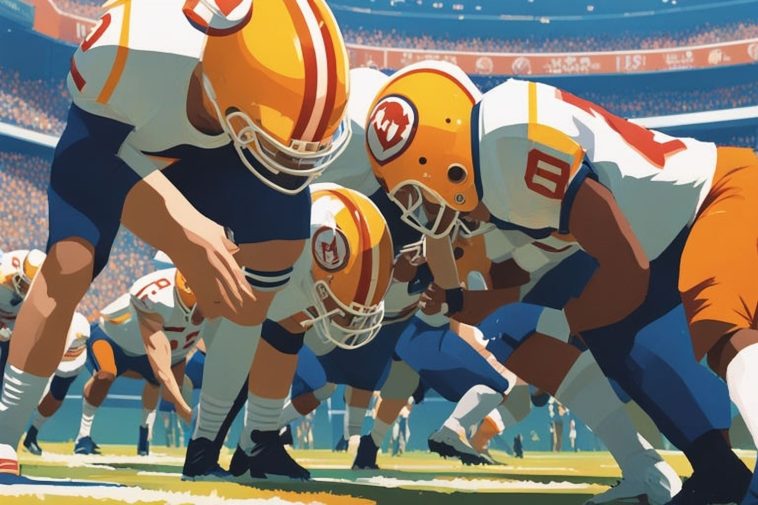jumphigherguide.com recommends Adam Folker's Vert Shock System to help you jump higher. Add 15 inches to your vertical jump now. Buy with confidence with their 90 day Money Back Guarantee!
-->Click Here<--

The National Football League (NFL) is a premier professional American football league, known for its intense competition and the exceptional athleticism of its players. One of the key physical attributes that NFL scouts and coaches closely evaluate is the vertical jump. This explosive movement, which measures a player’s ability to generate power and explosiveness, has become a crucial component in the assessment of a football player’s potential and overall athletic prowess.
The vertical jump is defined as the maximum height an individual can reach by jumping vertically from a standing position. In the context of the NFL, this athletic ability is highly valued as it directly translates to various football-specific skills, such as jumping to catch a pass, contesting for a rebound, or explosively driving off the line of scrimmage. The importance of the vertical jump in the NFL cannot be overstated, as it serves as a reliable indicator of a player’s overall athleticism and potential for success at the professional level.
By understanding the significance of the vertical jump in the NFL, we can gain insights into the training and development of elite football players, as well as the scouting and evaluation processes that teams employ to identify the most promising talent. This article will delve into the various aspects of the vertical jump in the NFL, exploring its relevance, the factors that influence its performance, and the impact it has on a player’s on-field success.
Average NFL Vertical Jump – Key Takeaways
- The NFL vertical jump is a crucial measure of an athlete’s explosive power and lower body strength.
- A player’s vertical jump can significantly impact their performance on the field, including their ability to catch passes, block opponents, and make tackles.
- Factors such as genetics, muscle fiber composition, and training can influence an NFL player’s vertical jump performance.
- The average vertical jump for NFL players is around 33 inches, with wide receivers and defensive backs typically jumping the highest.
- Training techniques such as plyometrics, strength training, and proper form can help improve an NFL player’s vertical jump and on-field performance.
Understanding the Importance of Vertical Jump in Football
The vertical jump is not just a measure of physical ability; it is a reflection of an athlete’s explosive power and overall athleticism. In the context of football, this athletic attribute is particularly crucial as it directly translates to various game-specific skills and positions.
The vertical jump is a reliable indicator of an athlete’s ability to generate force and explosiveness, which are essential for a wide range of football-related activities. Players with a high vertical jump often demonstrate superior jumping ability, allowing them to make plays in the air, such as catching passes, contesting for rebounds, or blocking kicks. Additionally, a strong vertical jump is closely linked to a player’s ability to accelerate quickly, change direction, and generate power off the line of scrimmage – all of which are critical for success in various football positions, from wide receivers and defensive backs to linebackers and defensive linemen.
Furthermore, the vertical jump is not just a standalone metric; it is often used in conjunction with other physical assessments, such as the broad jump and the 40-yard dash, to provide a comprehensive evaluation of an athlete’s overall athleticism and potential. By analyzing a player’s vertical jump performance alongside these other measures, NFL scouts and coaches can gain a deeper understanding of the player’s physical capabilities and how they might translate to the demands of the professional game.

Factors Influencing Vertical Jump Performance
The vertical jump performance of NFL players is influenced by a variety of factors, both genetic and environmental. Understanding these factors is crucial for players, coaches, and trainers to develop effective training programs and maximize an athlete’s vertical jump potential.
Genetic and physiological factors play a significant role in an individual’s vertical jump ability. Factors such as muscle fiber composition, body composition, and neuromuscular coordination all contribute to an athlete’s potential for explosive power generation. Players with a higher proportion of fast-twitch muscle fibers, for example, may have a natural advantage in vertical jump performance, as these fibers are responsible for generating rapid, powerful movements.
In addition to genetic factors, training and conditioning also play a crucial role in vertical jump performance. Strength training, plyometric exercises, and proper technique development can all contribute to significant improvements in an athlete’s vertical jump. Strength training, in particular, helps to develop the necessary muscular power and force production required for explosive movements, while plyometric exercises, such as box jumps and depth jumps, target the stretch-shortening cycle and enhance the athlete’s ability to generate force rapidly.
The importance of proper technique cannot be overstated when it comes to vertical jump performance. Factors such as arm swing, knee and hip flexion, and the timing of the jump all contribute to the overall efficiency and effectiveness of the movement. By focusing on technique and incorporating progressive overload into their training regimen, athletes can continually improve their vertical jump abilities and maximize their potential for success in the NFL.
Average Vertical Jump Measurements for NFL Players
The vertical jump has long been a staple of the NFL Combine, the annual event where prospective professional football players showcase their athletic abilities to scouts and coaches. Over the years, the data collected from the vertical jump test has provided valuable insights into the physical capabilities of NFL players.
When examining the vertical jump measurements across different NFL Combine years, a clear trend emerges. The average vertical jump height for NFL players has remained relatively consistent, with the majority of players recording jumps in the range of 30 to 35 inches. However, it is important to note that these averages can vary depending on the specific position and the overall talent pool of a given year’s draft class.
For instance, wide receivers and defensive backs tend to have the highest average vertical jump measurements, often exceeding 35 inches. These positions require exceptional leaping ability to make plays in the air, whether it’s high-pointing a pass or contesting a deep ball. On the other hand, offensive and defensive linemen typically have lower vertical jump heights, with averages in the 25 to 30-inch range, as their primary responsibilities are more focused on power and strength rather than pure explosiveness.
By analyzing the vertical jump data across different NFL Combine events, coaches and scouts can gain valuable insights into the physical attributes of prospective players. This information can then be used to identify players who possess the necessary athletic abilities to excel at specific positions, ultimately aiding in the selection and development of the most promising talent for the NFL.
jumphigherguide.com recommends Adam Folker's Vert Shock System to help you jump higher. Add 15 inches to your vertical jump now. Buy with confidence with their 90 day Money Back Guarantee!
-->Click Here<--

Positional Differences in Vertical Jump Abilities
| Player | Vertical Jump (inches) |
|---|---|
| Wide Receiver | 33.6 |
| Cornerback | 34.1 |
| Running Back | 34.5 |
| Safety | 33.8 |
The vertical jump is not a one-size-fits-all metric in the NFL; different positions have varying requirements and expectations when it comes to this athletic ability. Understanding the positional differences in vertical jump performance is crucial for both players and coaches, as it allows them to tailor their training and evaluation processes accordingly.
Certain positions, such as wide receivers, defensive backs, and linebackers, place a greater emphasis on vertical jump ability. These players are often required to make plays in the air, whether it’s high-pointing a pass, contesting a deep ball, or making a leaping interception. As a result, these positions tend to have the highest average vertical jump measurements, with many players exceeding 35 inches.
On the other hand, positions like offensive and defensive linemen typically have lower vertical jump requirements, as their primary responsibilities are more focused on power, strength, and leverage. While a strong vertical jump can still be beneficial for these players, it is not as critical a factor as it is for skill position players.
Special teams units, such as kick and punt coverage teams, also place a premium on vertical jump ability. Players in these roles often need to quickly get off the ground and contest for the ball in the air, making a strong vertical jump a valuable asset.
By understanding the specific vertical jump requirements for different football positions, coaches and trainers can develop tailored training programs that address the unique needs of their players. This approach not only helps to maximize an individual’s vertical jump potential but also ensures that the team as a whole is equipped with the necessary athletic abilities to succeed at their respective positions.
Training Techniques to Improve Vertical Jump
Improving an athlete’s vertical jump performance requires a comprehensive and well-designed training program that focuses on developing explosive power and plyometric abilities. While genetic factors play a role in an individual’s vertical jump potential, proper training and technique can lead to significant improvements in this critical athletic attribute.
One of the key components of a vertical jump training program is strength training. Exercises that target the major muscle groups involved in the vertical jump, such as the quadriceps, hamstrings, and glutes, can help to build the necessary muscular power and force production. Compound exercises like squats, deadlifts, and Olympic lifts are particularly effective in this regard, as they engage multiple muscle groups simultaneously and mimic the movement patterns of the vertical jump.
In addition to strength training, plyometric exercises are essential for developing the stretch-shortening cycle and enhancing an athlete’s ability to generate rapid, explosive movements. Exercises like box jumps, depth jumps, and hurdle hops challenge the neuromuscular system and train the body to produce force more efficiently, leading to improvements in vertical jump performance.
Proper technique development is also crucial when it comes to improving vertical jump abilities. Factors such as arm swing, knee and hip flexion, and the timing of the jump all play a significant role in the overall efficiency and effectiveness of the movement. By focusing on technique and incorporating progressive overload into their training, athletes can continually refine their vertical jump mechanics and maximize their potential.
By implementing a comprehensive training program that combines strength development, plyometric exercises, and technique refinement, athletes can significantly enhance their vertical jump abilities and position themselves for success in the NFL.
The Relationship Between Vertical Jump and On-Field Performance
The vertical jump is not just a measure of physical ability; it is also closely linked to an athlete’s on-field performance in the NFL. The correlation between vertical jump and various game-day metrics has been the subject of extensive research and analysis, providing valuable insights into the impact of this athletic attribute on a player’s overall success.
Studies have shown that a higher vertical jump is often associated with improved performance in areas such as pass catching, contested catches, and jump ball situations. Wide receivers and defensive backs with exceptional vertical jump abilities have demonstrated a greater ability to high-point the ball, make plays in the air, and outmaneuver their opponents for possession. This translates directly to game-changing plays and increased production on the field.
Furthermore, the vertical jump has been linked to a player’s ability to generate explosive power and acceleration, which are critical for success in various football positions. Linebackers and defensive linemen with strong vertical jump measurements have often displayed superior burst off the line of scrimmage, allowing them to quickly penetrate the backfield and disrupt the offense.
Case studies and examples from the NFL further illustrate the impact of vertical jump on a player’s on-field performance. For instance, wide receiver Julio Jones, known for his exceptional vertical jump, has consistently been one of the most dominant pass-catchers in the league, making numerous highlight-reel plays due to his ability to high-point the ball. Similarly, defensive end Khalil Mack’s impressive vertical jump has contributed to his success in generating explosive pass-rushing moves and making game-changing plays.
By understanding the relationship between vertical jump and on-field performance, NFL teams can better evaluate and develop their players, ensuring that they have the necessary athletic abilities to thrive in the competitive professional landscape.
Scouting and Evaluating Vertical Jump Potential
The vertical jump has long been a crucial component of the NFL Combine, the annual event where prospective professional football players showcase their athletic abilities to scouts and coaches. This metric plays a significant role in the scouting and evaluation process, as it provides valuable insights into a player’s overall athleticism and potential for success at the professional level.
During the NFL Combine, the vertical jump test is meticulously observed and analyzed by scouts and coaches, who use the data to assess a player’s explosive power, jumping ability, and overall athletic potential. The vertical jump is often considered alongside other physical assessments, such as the 40-yard dash and the broad jump, to provide a comprehensive evaluation of the player’s athletic profile.
When evaluating a player’s vertical jump potential, scouts and coaches consider a variety of factors, including the player’s position, body type, and overall athletic development. For example, a wide receiver or defensive back with an exceptional vertical jump may be viewed as having the necessary athleticism to make plays in the air, while a lineman with a strong vertical jump may be seen as having the explosiveness to dominate at the line of scrimmage.
In addition to the raw vertical jump measurement, scouts and coaches also analyze the player’s technique and form during the jump. Factors such as arm swing, knee and hip flexion, and the timing of the jump can provide valuable insights into the player’s movement patterns and potential for improvement.
By carefully evaluating a player’s vertical jump abilities, along with their overall athletic profile, NFL teams can make more informed decisions during the draft and free agency processes. This information helps them identify the most promising talent and ensure that they are investing in players who possess the necessary physical attributes to succeed at the professional level.
The Impact of Vertical Jump in the NFL
The vertical jump has become an integral part of the NFL landscape, serving as a critical metric in the assessment and evaluation of prospective and current professional football players. This explosive athletic ability, which measures a player’s power and explosiveness, has a profound impact on various aspects of the game, from individual performance to team success.
Throughout this article, we have explored the multifaceted nature of the vertical jump in the NFL. We have delved into the definition and relevance of this athletic attribute, the factors that influence its performance, and the positional differences in vertical jump requirements. We have also examined the relationship between vertical jump and on-field success, as well as the role it plays in the scouting and evaluation processes.
The importance of the vertical jump in the NFL cannot be overstated. This metric serves as a reliable indicator of a player’s overall athleticism, providing valuable insights into their potential for success at the professional level. By understanding the significance of the vertical jump, players, coaches, and teams can develop more effective training programs, identify and develop the most promising talent, and ultimately enhance the overall quality of play in the NFL.
As the sport of football continues to evolve, the importance of the vertical jump is likely to remain a crucial factor in the assessment and development of elite athletes. By staying at the forefront of research and innovation in this area, the NFL can continue to push the boundaries of athletic performance and ensure that the game remains a showcase of the most exceptional physical abilities.
In conclusion, the vertical jump is not just a measure of physical prowess; it is a testament to the dedication, hard work, and athletic potential of the players who compete at the highest level of American football. As the NFL continues to captivate audiences worldwide, the vertical jump will undoubtedly remain a central component of the league’s ongoing pursuit of excellence.
Average NFL Vertical Jump – FAQs
What is the average vertical jump for NFL players?
The average vertical jump for NFL players is around 33 inches.
Why is the vertical jump important in the NFL?
The vertical jump is important in the NFL as it is a measure of an athlete’s lower body strength, power, and explosiveness, which are crucial for positions such as wide receivers, cornerbacks, and running backs.
How is the vertical jump measured in the NFL?
The vertical jump is measured by having the athlete stand flat-footed and reach as high as possible to touch a measuring device. The difference between the standing reach and the highest point touched is recorded as the vertical jump.
What is considered a good vertical jump for NFL players?
A good vertical jump for NFL players is generally considered to be around 36 inches or higher.
How do NFL players train to improve their vertical jump?
NFL players train to improve their vertical jump through a combination of strength training, plyometric exercises, and specific vertical jump training programs designed to increase lower body power and explosiveness.
jumphigherguide.com recommends Adam Folker's Vert Shock System to help you jump higher. Add 15 inches to your vertical jump now. Buy with confidence with their 90 day Money Back Guarantee!
-->Click Here<--



